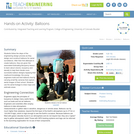
Students follow the steps of the engineering design process as they design and construct balloons for aerial surveillance. After their first attempts to create balloons, they are given the associated Estimating Buoyancy lesson to learn about volume, buoyancy and density to help them iterate more successful balloon designs.Applying their newfound knowledge, the young engineers build and test balloons that fly carrying small flip cameras that capture aerial images of their school. Students use the aerial footage to draw maps and estimate areas.
- Subject:
- Applied Science
- Engineering
- Mathematics
- Physical Science
- Physics
- Technology
- Material Type:
- Activity/Lab
- Provider:
- TeachEngineering
- Provider Set:
- TeachEngineering
- Author:
- Marissa H. Forbes
- Mike Soltys
- Date Added:
- 09/18/2014
